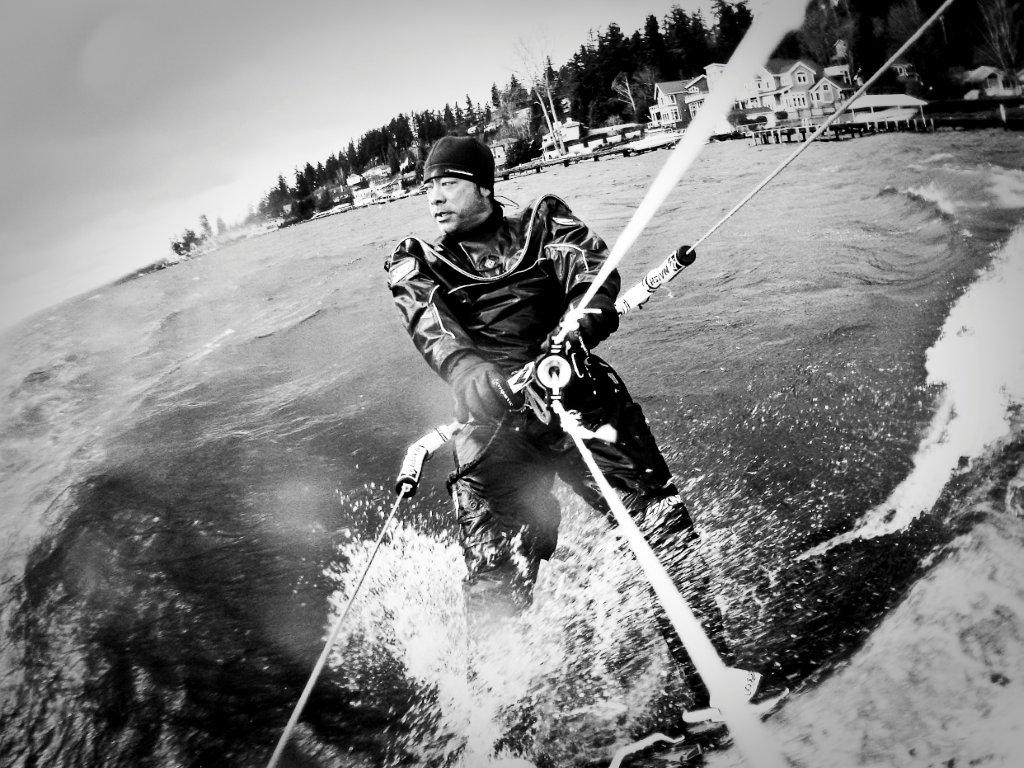By Mendy Maccabee, MD FACS
Outside of a great fitting harness, helmet, and untangled kite lines, a pair of earplugs is a must for any kiter. The reason is that ear injuries occur frequently, are very painful, and are easily preventable. Injuries are of two types: acute (immediate) and chronic (occur over time).
Acute injuries are generally eardrum perforations which occur from rapid pressure changes like smacking your head against the water after messing up your landing. These can occur even with a helmet on.

Photo Jim Stringfellow
Riders often suffer immediate dizziness or vertigo from exposing the middle ear to cold water which wreaks havoc with the balance organ. Adding insult to injury a middle ear infection often follows. Potentially, an operation is required to fix the perforation if it doesn’t close on its own.
While perforations of this sort usually do heal by themselves, I guarantee you the bill for your physician visit and medication are going to cost you more than the most deluxe set of custom ear plugs. Also, you will have to keep your ear dry for two weeks while the infection clears and your ear canal and drum heal.
Chronic injury is usually the formation of bony overgrowths in the ear canal called exostosis. Cold water and wind exposure are a problem for our ears and historically surfers have suffered the most publically. As kiting, white water kayaking, and other cold water sports have become popular and wet/dry-suit technology has improved the problem has become more widespread. Exostosis (plural: exostoses), commonly known as surfers ear, are bony growths (classically three) that develop in the ear canals of people exposed to cold water and/or wind (conditions familiar to anyone?).
As an ear, nose, and throat surgeon in a location surrounded by cold water and wind, I have to deal with the problem frequently. Water gets trapped behind these growths leading to ear canal inflammation and infection. Also, these growths narrow your ear canal resulting in less sound wave transmission, a plugged sensation, and conductive hearing loss. If ear infections become frequent, hearing loss noticeable, or they grow large enough to touch each other or block your ear drum, they need to be removed surgically.
You can avoid all this by spending money on a good set of ear plugs! A big downside (outside of having an operation) is six weeks recovery time and no water contact during this recovery period! It’s worth mentioning that this condition is also encountered (although less commonly) in warm water locations as the wind cools the water even on a warm day.
The good news is that exostoses development is a slow process and as they say, “an ounce of prevention is worth a pound of cure.” If you wear ear plugs to keep the water and wind out of your ears you shouldn’t develop the problem in the first place. If you already have exostoses they likely will not continue to grow if you prevent further cold water/wind exposure although the exostoses you already have are permanent and will not recede by wearing plugs.
So how cold is too cold to go without ear plugs? I haven’t seen a scientific paper that designates a specific temperature, but I tell my patients that if you wouldn’t jump in naked and be comfortable you should wear your ear plugs!
There are several companies that make generically sized ear plugs to protect your ear canals and drums from cold water and wind. Doc’s ear plugs, for example, come in small, medium, and large. You can buy them at your local surf shop. They are inexpensive, easy to use, and work reasonably well, but I prefer custom plugs for many reasons. They have a large diaphragm that is sturdy, keeps water and wind noise out, and still allows good hearing.
Here in the Gorge, hearing preservation is important for the constant barge traffic we experience on the water. You will also be surprised how much more peaceful your sessions on the water are in absence of wind noise. Also, they fit your ears perfectly so they stay put.
Having seen and cared for many riders with ear drum rupture, I am sure you will be happy to have them stay put when you blow your first kite loop. They float and you can choose up to three custom colors making them easy to find, which can be handy if you accidentally drop them in the water or they find their way to the bottom of your gear bin. They also come on a nylon cord so you can hang them around your neck when you remove them.
Custom plugs need to be molded to your ear canal by an ear, nose, and throat physician or an audiologist and, as far as I know, are made by only one company, Westone. They also make professional musician plugs, military/artillery plugs, noise protection plugs, and a variety of water protection plugs. I prefer style #70 (full mold, short canal length). They generally take about 1-2 weeks to arrive once molded (which takes about five minutes) and cost around $80 — a small investment that will more than pay itself off, keep you on the water, and most importantly, save your ears and hundreds or even thousands of dollars in potential medical bills.


